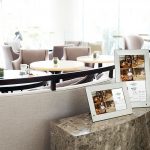The digital world and the physical world are becoming more and more integrated, and nowhere is that clearer than with interactive wayfinding. This is more than just putting some maps up on a screen. People today interact with visual information in a number of ways, and there are some simple but effective best practices you can follow during the design process to ensure your digital wayfinding is clean, clear and easy to use.
Digital designers are experts at UX and wayfinding design, and your organization is an expert on your facility. Meshing expertise from both groups with careful planning and open communications throughout the design process will ensure you get a wayfinding design to meet your goals and your audience’s expectations.
We asked for advice from our creative team at Visix to help customers with the wayfinding design process, and here’s what they said.
Make it clear and colorful
Don’t crowd your wayfinding design
Clean, simple designs are faster and easier for your visitors to comprehend. Speed of service is a main determiner in visitor satisfaction, so make it as effortless as possible for them to find their route. If you need to provide a lot of information, consider an interactive design with multiple screens, of which wayfinding can be just one. That way, people can sort and sift through the information they need at their own pace. But we suggest you put the wayfinding up front, so they don’t have to dig through a long navigation process to find it.
Think about color-coding maps
This is another way to make the wayfinding process faster and more memorable for visitors. Take inspiration from examples you’ve seen elsewhere, or use your brand identity colors, but always have a rationale. For example, maybe all the meeting rooms are one color, all the break rooms another. Don’t just do this to make it look nice, and don’t use a hundred colors – it needs to make sense and be useful to your audience. It also might be more cohesive if you match the actual colors in the building with the maps. So, if a particular area has green walls, make them green on the map as well. If you have printed wayfinding placards in addition to digital wayfinding, those color systems need to match.
Show them the way
Use visual paths
Route lines are often more effective than animated or static you are here and destination icons. If your facility is large enough to use digital wayfinding, then it’s likely that most routes are going to involve several steps. (In some cases, a person may have to change floors or even buildings.) With route lines, a person gets a full visualization of going from where there are (the display) all the way to their destination, instead of simply a dot in the distance that they then have to think about how to get to. You might also consider color-coding route lines – one color for walking, another for elevators, a third for driving, etc.
Standardize icons
You can still include start and endpoint icons in your design – every clear visual cue helps your audience. You should also include recognizable icons to mark other common destinations like restrooms, elevators and exits. Again, find the most common areas that people need to go and mark them on maps. If you’re not sure, set up an info or reception desk at your main entrance for a week, and note when people ask directions.
Meet ADA guidelines
Don’t forget to design in accessibility to meet ADA guidelines. This usually means having everything that’s touchable on the screen at the bottom (or duplicated in an ADA menu) for easy access. You might also consider other disabilities, like colorblindness, when choosing design elements and colors. Your design team should be able to make recommendation\aa
For more information about AdcommTV’s commercial digital display signage solutions, please email us at helpdesk@adcommtv.com or contact our call center at 866-272-7982. Please also visit this page on our website: https://adcommtv.com/products/digital-signage//



